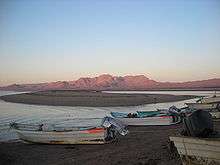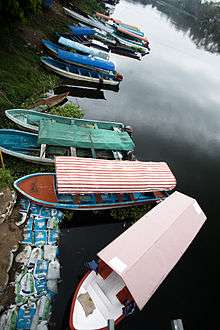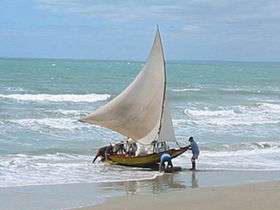Panga (skiff)
The Panga is a type of modest-sized, open, outboard-powered, fishing boat common throughout much of the developing world, including Central America, the Caribbean, parts of Africa, the Middle East, and much of Asia. The original panga design was developed by Yamaha as part of a World Bank project circa 1970.[1][2][3] Pangas are commonly operated directly off beaches.[4] The name comes from the panga fish, which is commonly netted. The upswept bow of the boat resembles the machete or knife called a panga.



Key features of the panga design are a high bow, narrow waterline beam, a delta shaped running surface[5], and a flotation bulge along the gunwale, or top edge of the hull. The high bow provides buoyancy for retrieving heavy nets, and minimizes spray coming over the bow. The narrow beam allows the hull to be propelled by a modest outboard motor. The flotation bulge along the gunwale provides increased stability at high angles of roll. These features link the panga design to traditional Japanese wasen fishing boats.
The original Yamaha panga design had a length of 22 feet (6.7 m), and a waterline beam of approximately 5 feet 6 inches (1.7 m). The flotation bulge at the gunwale increased the overall beam to approximately 6 feet 6 inches (2.0 m).
Pangas are usually between 19 and 28 feet (5.8 and 8.5 m) in length, with capacities ranging from 1 to 5 short tons (0.89 to 4.46 long tons; 0.91 to 4.54 t) and powered by outboard motors of between 45 and 200 hp (34 and 149 kW). Their planing hulls are capable of speeds in excess of 35 knots (40 mph; 65 km/h).
The hulls are made of fiberglass or fibre-reinforced plastic (FRP), heavily reinforced by numerous bulkheads, and usually have bow and stern enclosed flotation compartments.
They are considered extremely seaworthy in the hands of an experienced operator.
Variations
Various boat manufacturers have created designs either based on or inspired by the original panga design, some with more modern amenities than the original panga skiff.[6][7]
References
- Panga history at Allmand Boats. Retrieved from http://allmandboats.blogspot.com/.
- Panga history at Microskiff. Retrieved from http://www.microskiff.com/reviews/boats/PangaMarine_18_skiff.html.
- Panga article at Soundings Online. Retrieved from http://www.soundingsonline.com/features/type-of-boat/178-the-versatile-panga-is-coming-of-age-.
- Video of a panga landing on a beach in Mexico. Retrieved from https://www.youtube.com/watch?v=uNW0n9PlKGc
- September 05, Staff | on; 2019 (2019-09-05). "The benefits of cruising in a Panga". Charlotte County Florida Weekly. Retrieved 2020-06-06.CS1 maint: numeric names: authors list (link)
- "Sarasota Boat builder aims to ride big growth wave | Business Observer". Business Observer. 2019-09-01. Retrieved 2020-06-06.
- "Angler 22 Panga". Florida Sportsman. 2014-08-12. Retrieved 2020-06-06.
